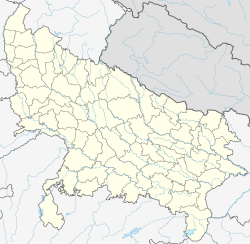Binodpur
In this article, Binodpur will be addressed with the purpose of analyzing its importance and relevance today. Binodpur has been the subject of numerous studies and debates over the years, demonstrating its impact in different areas of society. Likewise, this topic has given rise to conflicting opinions among experts and specialists, which makes it necessary to deepen its study and understanding. Through a detailed analysis, different approaches and perspectives around Binodpur will be explored, in order to provide a comprehensive view of its meaning and impact in the current context.
Binodpur | |
|---|---|
Village | |
| Coordinates: 27°16′08″N 79°12′53″E / 27.2688°N 79.21469°E | |
| Country | India |
| State | Uttar Pradesh |
| District | Mainpuri |
| Tehsil | Bhongaon |
| Area | |
• Total | 1.121 km2 (0.433 sq mi) |
| Population (2011)[1] | |
• Total | 1,966 |
| • Density | 1,800/km2 (4,500/sq mi) |
| Time zone | UTC+5:30 (IST) |
Binodpur (Binodpur), also spelled Vinodpur, is a village in Bewar block of Mainpuri district, Uttar Pradesh, India. As of 2011, it had a population of 1,966, in 348 households.
Demographics
As of 2011, Binodpur had a population of 1,225, in 212 households.[1]: 186 This population was 53.7% male (1,056) and 46.3% female (910). The 0-6 age group numbered 301 (173 male and 128 female), or 15.3% of the total population. 485 residents were members of Scheduled Castes, or 24.7% of the total.[2]: 136–7
The 1981 census recorded Binodpur as having a population of 1,262 people, in 246 households.[3]: 180–1
The 1961 census recorded Binodpur as comprising 1 hamlet, with a total population of 889 people (463 male and 426 female), in 181 households and 120 physical houses. The area of the village was given as 260 acres; it was then counted as part of Allau block.[4]: cii
Infrastructure
As of 2011, Binodpur had 1 primary school; it did not have any healthcare facilities. Drinking water was provided by hand pump; there were no public toilets. The village did not have a post office or public library; there was at least some access to electricity for all purposes. Streets were made of both kachcha and pakka materials.[1]: 186–91
References
- ^ a b c d "Census of India 2011: Uttar Pradesh District Census Handbook - Mainpuri, Part A (Village and Town Directory)" (PDF). Census of India. Retrieved 19 June 2023.
- ^ "Census of India 2011: Uttar Pradesh District Census Handbook - Mainpuri, Part B (Village and Town Wise Primary Census Abstract)" (PDF). Census of India. Retrieved 19 June 2023.
- ^ Census 1981 Uttar Pradesh: District Census Handbook Part XIII-A: Village & Town Directory, District Mainpuri (PDF). 1982. Retrieved 25 July 2023.
- ^ Census 1961: District Census Handbook, Uttar Pradesh (24 - Mainpuri District) (PDF). Lucknow. 1965. Retrieved 25 December 2021.
{{cite book}}: CS1 maint: location missing publisher (link)
